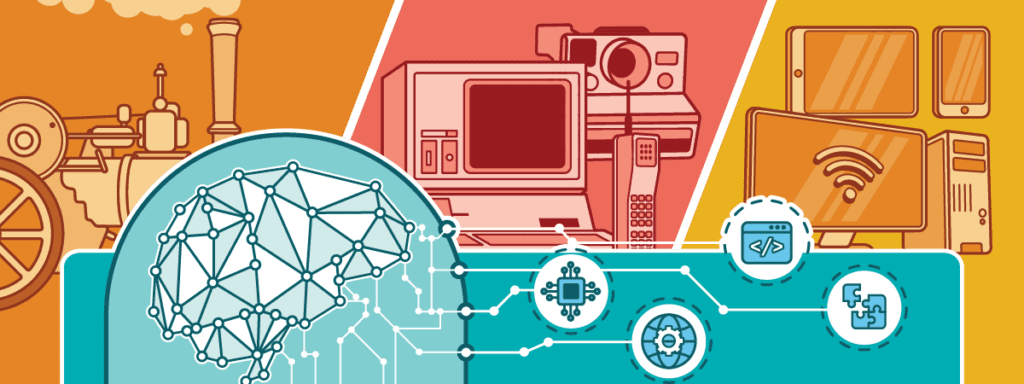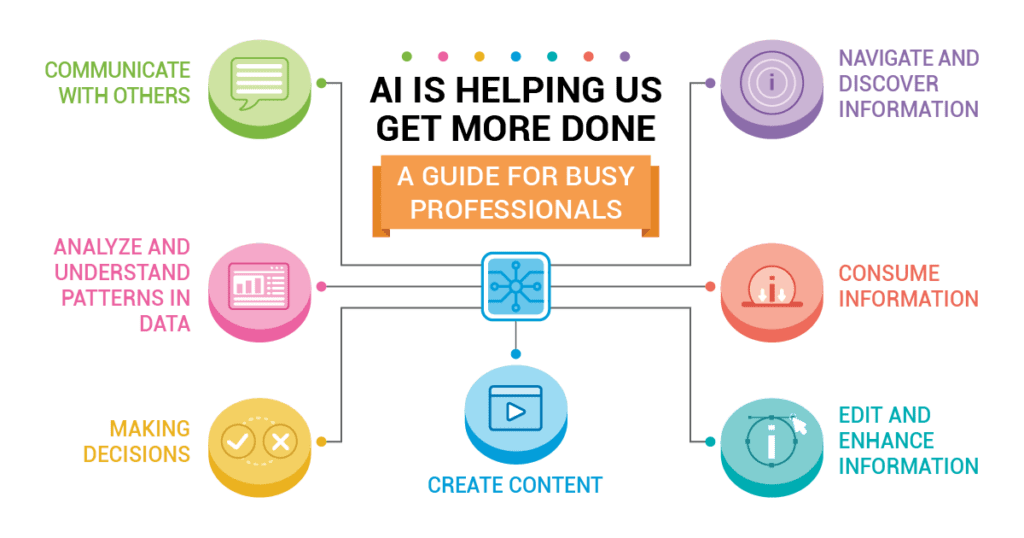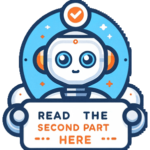Table of Contents
Toggle
Technology and human imagination are seamlessly intertwined to make our lives more efficient, creative, and impactful. Artificial Intelligence is propelling us towards this reality. Today, we will take a deep dive into AI’s transformative power and its impact on productivity across personal, public, and professional spheres. But first, let’s understand technology’s journey and its role in enhancing productivity.
Think back to the 18th century, the era of the Industrial Revolution, when steam-powered machines kicked off a new age of mechanization, skyrocketing our productive capabilities. Now, fast-forward to the 20th century, we are in the midst of the electric revolution, a period marked by assembly lines, telecommunication, and electrification – this era redefined the speed and efficiency of production.
The Information Age, the late 20th and early 21st century, connected the world through personal computers and the internet, making information easily accessible with just a click and redefining productivity.
And now, we find ourselves on the brink of a new era where AI is pushing productivity boundaries with its ability to learn, reason, and self-correct. Pretrained models are reducing entry barriers for AI applications and democratizing AI. AI is reshaping our operational paradigm in personal, public, and professional scenarios.
A Close Look at Pretrained Models
If you’ve ever used an online translator or asked a voice assistant for the weather, then congratulations! You’ve used a kind of Artificial Intelligence (AI) called a pretrained model.
What are pretrained models?
In the world of AI, a pretrained model is like a super-smart helper that has already done a lot of learning before it gets to you. It’s a machine learning model that has been trained on a huge amount of data beforehand. This data can be pictures (for image recognition) or sentences (for understanding and generating language), among other things.
- For example, a large language model like ChatGPT (the ‘P’ stands for ‘Pretrained’) has been trained on a huge number of texts so it can generate human-like text based on the input you give it. Such models can be likened to a ballet dancer transitioning into football. Just as the dancer’s refined footwork and balance from ballet training offer an advantage on the football field, the broad training of these models on diverse text equips them with versatile language skills. These skills can be transferred to various language-related tasks, much like the ballet-to-football advantage, enhancing performance across multiple areas. This is what we call transfer learning in AI– where knowledge gained while solving one problem is applied to a different but related problem.
Why are pretrained models important?
Think about the considerable resources that tech giants like Google, Microsoft, Facebook, and OpenAI have at their disposal. They’ve trained complex AI models using extensive data science and computational power, resources that most individuals don’t have. It’s akin to learning how to ride a bike for the first time – it requires significant time and effort. But once it’s learned, it doesn’t need to be learned again. Similarly, these companies have done the heavy-lifting of training AI models, and we can utilize these pretrained models. We benefit from their expertise and resources without the need to be data scientists ourselves or possess supercomputing capabilities.
- By using a pretrained model, you’re using a model that already knows a lot. You can use its existing knowledge and tweak it to suit your specific needs. Plus, many pretrained models are available for free online. This means anyone with a computer can use AI, just like how anyone with a bike can go cycling.
How can we use pretrained models?
There are two main ways to use pretrained models: use them “as-is” or fine-tune them.
When you use a pretrained model “as is,” you’re using it just like it came out of the box. This is great for non-technical people, as they can use AI without needing to understand all the math and computer science behind it. For example, if you’re a teacher, you could use a language model to check for spelling or grammar errors in student essays.
- Fine-tuning a pretrained model is like customizing your bike. Maybe you need a basket for your grocery shopping or a bell to let people know you’re coming. In the same way, you can train your pretrained model on a smaller, specific dataset to better suit your needs. This might mean training ChatGPT on legal documents if you’re a lawyer so it can help draft contracts or court documents.

AI is Helping Us Get More Done: A Guide for Busy Professionals
Imagine having a super-smart helper that can assist you in doing things faster and better. This isn’t science fiction anymore; this is Artificial Intelligence, or AI. AI is changing the way we do many things in our lives. Let’s see how.
- AI is changing the way we create content
Generative AI is causing a massive shift in how we create content across various professions. Accelerating the content creation process while opening new avenues for creativity and innovation, it’s like having an ever-ready, ever-creative assistant to help bring the most imaginative ideas to life.
- AI tools like OpenAI’s GPT-4 can assist writers in generating ideas, drafting articles, and creating full narratives. For example, a journalist might input a news headline, and GPT-4 can draft a news article based on it. AI tools like GrammarlyGo can help writers by proofreading content and suggesting improvements in grammar, style, and clarity.
- AI platforms like DALL-E, developed by OpenAI, can generate unique images from text descriptions. This could be immensely useful for graphic designers in creating quick mockups or for artists to bring their creative visions to life. An artist could input a description like “a tranquil forest with floating lanterns at dusk,” and DALL-E could generate a stunning image reflecting this.
- AI tools like Google’s MusicLM can generate new music in a wide range of styles and genres. A musician could ask MusicLM to create a melody in Mozart’s style, providing a unique base for their own composition. Tools like Descript’s “Overdub” feature allow sound engineers to generate new voiceovers just by typing in text.
- AI is transforming video creation and animation as well. DeepArt and DeepDream can transform regular video footage into unique works of art, using different visual styles. Tools like Runway ML offer AI capabilities for creating, editing, and augmenting videos easily.
- For marketing and advertising professionals, AI tools like Copy.ai and Jasper can create engaging advertising copy based on a product description. AI can also generate eye-catching visuals for ads. Tools like Canva’s “design suggestion” feature use AI to recommend visually appealing layouts and designs.
- AI is changing the way we navigate and discover information
AI is significantly improving our ability to navigate and discover information in large data sets. It is not just speeding up the information retrieval process, but also making it more accurate and efficient. Furthermore, AI enhances our search experience by utilizing image recognition to analyze and extract specific details from pictures. By understanding and processing data in ways similar to the human brain, AI is revolutionizing how we navigate and discover information.
- Researchers often need to sift through huge databases of articles and papers for their work. AI tools like Semantic Scholar use natural language processing and machine learning to understand the content of papers, helping researchers find relevant studies more easily and accurately.
- For lawyers and paralegals, navigating through vast amounts of legal documents is a daily task. AI-powered platforms like ROSS Intelligence can understand and answer legal questions, find relevant case law, and even predict court outcomes, saving valuable time.
- Medical professionals often need to stay updated with the latest research and patient data. AI tools like IBM Watson Health can analyze medical literature and patient data to provide doctors with evidence-backed treatment options.
- Journalists need to keep up with the latest news and events, which can involve navigating through a lot of information. AI tools like NewsWhip use predictive analytics to highlight trending topics and stories, helping journalists stay ahead of the news cycle.
- Managing and retrieving information from large databases is a primary task for librarians. AI tools like Yewno Discover use AI to semantically link concepts across a vast range of resources, allowing librarians and users to discover and explore information more intuitively.
- AI is changing the way we consume information
AI-powered summarization is transforming how we consume information across a range of professions. It not only saves time but also ensures that the consumption of information is focused and efficient. It’s like having a personal assistant to read through everything and highlight just what you need to know!
- Busy executives and managers often have to consume large volumes of reports, emails, and news. AI tools like SMMRY and SummarizeBot can condense these large texts into concise summaries, saving them precious time and allowing them to quickly grasp the key points.
- Students and educators often need to digest vast amounts of academic material. Tools like Resoomer can help by providing concise summaries of long texts, enabling quick revision or overview of a topic.
- Journalists need to stay updated on various topics, which can involve reading many reports or articles daily. AI-powered news apps like Inshorts use AI to provide 60-word summaries of news articles, keeping them informed without requiring much time.
- Lawyers often need to go through large legal documents. AI platforms like LegalRobot can summarize these documents, highlighting the key terms and conditions, saving time and effort.
- Medical professionals need to stay updated with the latest research and medical literature. AI tools like DistilBio can summarize these lengthy papers, enabling quick access to key findings and observations.
- AI is changing the way we edit and enhance information
AI is revolutionizing the way we edit and enhance information across various job roles. It is not only making information enhancement quicker but also more efficient and precise. It’s like having a professional editor or enhancer that’s always available, helping you deliver high-quality content every time.
- AI tools like Grammarly and ProWritingAid can detect grammar errors, improve writing style, and enhance readability. It’s like having an expert editor at your side as you write, helping to polish your content in real-time.
- AI technology is changing how we restore and enhance images. Tools like Adobe’s Super Resolution can upscale images without losing detail, and software like Topaz Labs’ DeNoise AI can reduce noise in images, improving their quality.
- AI is also improving audio quality. Tools like Krisp can reduce background noise during calls or recordings. Descript, an AI-powered audio editor, can help in editing and enhancing audio files by converting speech to text, allowing you to edit the text to change the audio.
- AI is revolutionizing video editing. Tools like Runway ML can automate tasks such as object detection and segmentation, style transfer, and even generate new video content. Adobe’s Auto Reframe feature in Premiere Pro uses AI to automatically keep the main subject in frame, making it easier to edit videos for different platforms.
- AI tools like Google’s AutoML Tables can automatically clean up datasets and enhance them by identifying missing or faulty data, allowing analysts and scientists to focus more on insights rather than data cleaning.
- AI is changing the way we communicate with others
AI is transforming how we communicate across languages, making it easier for professionals of all kinds to connect globally. Machine translation (MT) refers to the application of computer software to translate text or speech from one language to another without human intervention. By breaking down language barriers, AI is enabling more effective communication between people, irrespective of their native languages. It’s like having a personal interpreter at your fingertips, ready to bridge the language gap at any time.
- In the global business world, communicating across languages is often a necessity. AI-powered translation tools like Google Translate or DeepL Translator can instantly translate text or speech, making cross-language business communication smooth and efficient.
- For customer service representatives dealing with customers worldwide, AI chatbots like IBM Watson Assistant can provide automated responses in various languages, improving customer experience and response time.
- In the travel and hospitality industry, interacting with customers from different linguistic backgrounds is common. Tools like the Microsoft Translator app can help translate real-time conversations, enhancing customer interactions.
- In diverse communities, healthcare professionals often encounter language barriers with patients. AI translation tools can help in such scenarios, ensuring clear communication and better patient care.
- Journalists and researchers often need to understand and cite foreign language sources. AI-powered tools like Google’s Translatotron can translate foreign speech directly into the user’s voice, maintaining the speaker’s original voice characteristics.
- Educators in multilingual classrooms can use AI tools like ClassDojo’s Translate to instantly translate messages to parents in their preferred language, enhancing communication between school and home.
- AI is changing the way we analyze and understand patterns in data
AI is not just revolutionizing how we understand and analyze patterns in data; it’s making data analytics more accessible and user-friendly, akin to having a personal, highly intelligent data scientist at your disposal. It’s facilitating new ways of interacting with data through plugins, extensions, natural language querying, natural language programming, and natural language chart generation.
- Plugins and Extensions: Tools like the Google Analytics plugin for Google Sheets employ AI to help users access and analyze their website data directly within Sheets, eliminating the need to navigate the complex Analytics dashboard. AI-powered Excel extensions, like Knoema’s DataFinder, allow users to find and incorporate relevant global data directly into their spreadsheets.
- Natural Language Querying: Power BI’s Q&A feature leverages AI to let users ask questions about their data in natural language and receive immediate answers. Similarly, ThoughtSpot’s search-driven analytics uses AI to allow users to explore their data just by typing or speaking questions in natural language.
- Natural Language Programming: OpenAI’s Codex is a prime example of AI making programming more accessible. It interprets natural language commands and writes the corresponding code, thereby enabling non-programmers to build software or automate tasks without having to learn coding languages.
- Natural Language Chart Generation: Tableau’s “Ask Data” feature employs AI to interpret natural language queries and generate corresponding visualizations. Users can simply type in a question like “What were the sales last quarter?” and the system will produce an appropriate chart.
- AI is changing the way we make decisions
AI is significantly transforming the way we make decisions across various job roles by providing reliable recommendations and automating tasks. It not only aids in decision-making but also automates repetitive tasks, allowing professionals to focus more on strategic and creative aspects of their work. It’s like having a knowledgeable advisor and efficient assistant rolled into one, making work more productive and decisions more data-driven.
- Pretrained large language models serve as the core of AI assistants, like Google Assistant, Siri, or Alexa. These AI assistants can provide real-time information, answer queries, schedule appointments, and even offer predictive suggestions based on our behavior patterns. They essentially democratize expert knowledge, as they can pull information from various domains, from medical advice to cooking tips, thus assisting in everyday decision-making. The ability of AI to understand and generate human-like text allows these assistants to interact with us in a natural and intuitive way.
- Consider your email inbox; AI algorithms can learn your preferences over time and automatically categorize incoming mail, highlighting important messages, and filtering out spam or promotional emails. This automation offloads mundane tasks, freeing up time and cognitive space for more complex decision-making.
In the first part of our exploration, we’ve seen how AI is reshaping planning and strategy development, transforming the way we understand problems, brainstorm ideas, and prototype solutions. From AI assistants enhancing problem-solving to technology streamlining the design process, we’re just scratching the surface of AI’s potential in boosting productivity.
Stay tuned for Part 2, where we delve deeper into how AI revolutionizes data analytics, simplifies complex analyses, navigates vast information landscapes, and innovates in building and creating. The journey into AI’s impact on our personal and professional lives continues.
